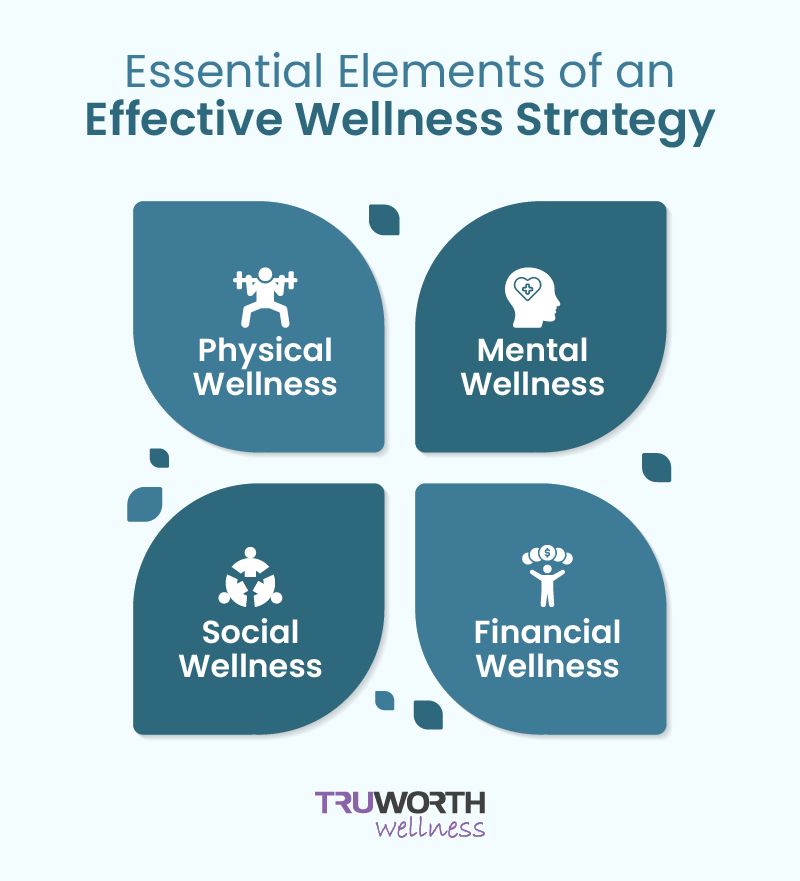Enhance Your Employee Wellness Strategy With These Well-Being Components

Your employees are the lifeblood of your organization, driving its success and growth. To unlock their full potential, it is crucial to prioritize their well-being. While traditional corporate wellness programs have focused on physical health, it is time to take a leap forward and embrace a more holistic approach.
By addressing the interconnected components of well-being—physical, mental, financial, and social—you can create a workplace that empowers employees to thrive. This article explores the power of a comprehensive wellness strategy and the importance of incorporating an Employee Assistance Program (EAP) to support your employees' overall well-being.
A successful corporate wellness program goes beyond addressing only the physical aspect of employee well-being. While physical wellness is crucial, neglecting mental and emotional well-being can significantly impact both employees and the organization. To create a truly effective program that positively impacts your organization, it's important to upgrade your approach and incorporate additional components of well-being. One such component is the Employee Assistance Program (EAP), which plays a vital role in supporting the overall health and well-being of employees. In this article, we will explore the significance of EAPs and how they can enhance your corporate wellness program.
The Importance of Comprehensive Employee Wellness:
Addressing the overall health and well-being of employees is imperative for a successful corporate wellness program. This involves recognizing the interconnectedness between different components of health, including physical, mental, financial, and social wellness. By understanding these connections, organizations can proactively support employees in maintaining a healthy and balanced lifestyle. To illustrate this, let's consider an example: if an employee is facing a financial crisis due to a family problem, it can negatively impact their mental and physical health, ultimately leading to poor performance and reduced productivity at work. By addressing all aspects of well-being, organizations can foster a happier and more productive workforce.
Employee Wellness Strategy Components

Physical Wellness:
Physical wellness is often the primary focus of corporate wellness programs. It includes exercise, proper nutrition, and diet plans promoting preventive measures for enhancing physical health. Some benefits you can offer to support physical wellness include:
- Annual corporate health check-up
- Online doctor consultations
- Step challenges for physical activity
- Nutrition coaching
- Walking meetings
- Promoting healthy eating habits
- On-site fitness classes or gym memberships
- Ergonomic assessments and adjustments to improve workplace comfort.
- Health coaching programs for weight management or chronic disease management
- Promoting a culture of taking regular breaks and encouraging movement throughout the day
- Offering incentives or rewards for achieving physical wellness goals
Mental Wellness:
Mental wellness is a vital but often overlooked component in many organizations' wellness strategies. Mental well-being is a personal topic that should be openly discussed and supported in the workplace. To address mental health concerns, it is crucial to incorporate specific initiatives into your employee wellness program.
- Online meditation classes
- One-on-one helpline for confidential support
- Employee Assistance Program (EAP) for counseling services
- Stress management programs
- Resources and education on emotional well-being
- Mental health awareness campaigns and workshops
- Providing resources for stress reduction techniques, such as mindfulness or breathing exercises
- Flexible work arrangements to support work-life balance and reduce stress.
- Creating a supportive and inclusive work environment that promotes open communication and psychological safety.
- Training managers and supervisors on mental health awareness and supportive leadership practices
Social Wellness:
Social wellness is another important but commonly ignored component of employee wellness. Employees can feel lonely or isolated in the workplace, leading to anxiety, stress, and depression. To foster social wellness, it is essential to encourage strong work relationships and a sense of community among employees.
- Fun workplace activities
- Team outings and bonding activities
- Celebrating team successes
- Wellness challenges promoting social connections.
- Organizing healthy potlucks
- Encouraging team lunches and breaks together.
- Providing access to social communities or groups
- Employee resource groups or affinity groups foster a sense of belonging and inclusivity.
- Organizing team-building activities and volunteer opportunities
- Encouraging social interactions through designated social spaces or shared areas
- Implementing mentorship or buddy programs to ease connections between employees.
- Recognizing and celebrating personal and professional milestones of employees
Financial Wellness:
Financial wellness plays a significant role in employees' overall health and happiness. Ignoring financial well-being can have adverse effects on employees' complete health and other areas of their lives. Incorporating financial wellness into your employee wellness program is essential to educate employees about financial management and help them navigate financial challenges.
- Offering financial counseling services
- Sharing knowledge resources on financial management
- Organizing workshops and sessions focusing on financial wellness
- Guiding employees on investment options based on their needs.
- Supplying information on budgeting and financial planning
- Helping programs for financial emergencies or difficulties
- Offering employee benefits packages that include financial planning resources, retirement planning aid, and insurance options.
- Providing workshops or webinars on budgeting, saving, and debt management
- Offering employee discounts or exclusive offers on financial products or services
- Introducing flexible compensation options, such as flexible spending accounts or stock options
- Partnering with financial institutions to provide access to financial literacy programs or personalized financial advice.
Conclusion:
To create a successful corporate wellness program, it is vital to go beyond the traditional approach of focusing solely on physical wellness. By incorporating components such as mental, social, and financial wellness, organizations can better support employees' overall well-being and create a healthier and happier workforce.
An Employee Assistance Program (EAP) plays a crucial role in addressing mental health concerns and providing employees with the necessary support. By upgrading your corporate wellness program and incorporating an EAP, you can truly make a positive impact on the well-being of your employees and the success of your organization.